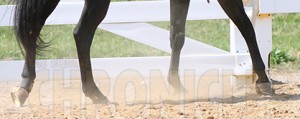Smooth Movement of Gaited Horses Caused by Genetic Mutation, Claims Study
Texas A&M University Media
COLLEGE STATION, TX – The smooth movement of gaited horses is caused by a genetic mutation that can be found across the world, according to a recent study.
The paper, “Worldwide frequency distribution of the ‘Gait keeper’ mutation in the DMRT3 gene,” was published Tuesday in the journal Animal Genetics.
“We have previously demonstrated that a single mutation in the DMRT3 gene has a large impact on gaitedness in horses, and it was therefore named ‘Gait keeper,’” said Dr. Leif Andersson, one of the authors of the article and a Texas A&M University Institute for Advanced Study Faculty Fellow collaborating with researchers at the College of Veterinary Medicine & Biomedical Sciences (CVM). This gene codes for a protein in a specific subset of neurons in the spinal cord that coordinates the movements of the animal’s legs. The mutated version of the gene causes a truncation of the DMRT3 protein, a genetic “mistake” that allows horses to pace and amble.
“The CVM has a reputation as a world leader in genomic research,” said Dr. Eleanor M. Green, Carl B. King Dean of Veterinary Medicine. “The collaborative efforts of our genomic scientists will continue to make an impact, not only in the equine industry through studies such as this one, but also in other species, including humans, through the application of the lessons learned from this investigative approach. This study is yet another example of contributions to One Health.”
This recent research shows that the mutation arose only once and then spread across the world via positive selection, Andersson said. In other words, early humans probably noticed that some horses had the ability to move in unique ways, and they then selected those horses for breeding, most likely because they offered a smoother, more comfortable ride, called a “running walk” in some breeds. Horse breeds that are known to perform these “ambling gaits” are referred to as “gaited,” and the researchers found that the mutated version of the gene is common in these breeds. They analyzed genes of 4396 horses from 141 breeds and found that the mutation is spread across Eurasia from Japan to the British Isles, in Iceland, in South and North America, and in breeds from South Africa.
“During such ambling gaits, the horse has at least one foot on the ground, which means that the vertical movement of the rider is minimal,” Andersson said. “For instance, Paso Fino is a breed from Latin America in which the frequency of the ‘Gait keeper’ mutation is nearly 100 percent. It is claimed that the Paso Fino gait is so smooth that you can have a glass of wine in your hand without letting it spill!”
“Now that we have the genetic tools with enough power, we are beginning to find unexpected insights into how genes influence movement,” said Dr. E. Gus Cothran, a clinical professor in the Department of Veterinary Integrative Biosciences at the CVM and another of the article’s authors. “Dr. Andersson and I are hoping to continue this work with the goal of understanding how other genes can influence the basic gait pattern inferred by DMRT3.”











